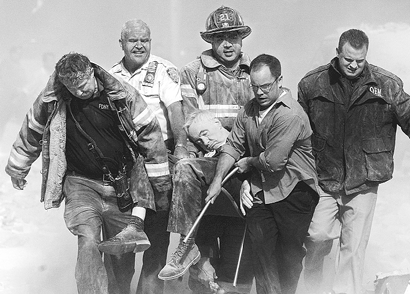Tribeca Film Festival—mainstream and marginal
When the Tribeca Film Festival began in 2002, neighborhood boosterism ranked as high on its agenda as cinephilia. That was understandable—in the wake of 9/11, the festival was created with the intent of helping downtown businesses and increasing foot traffic in Tribeca. However, these goals—and the festival’s connections to Robert de Niro—often seemed to overshadow the films themselves.
It’s a much different event than the extremely selective New York Film Festival. Considering that it begins several weeks before Cannes, where many NYFF entries receive their international premieres, it had to be. It always receives a great deal of mainstream media attention, and this year’s festival, which includes “Mission: Impossible 3,” “Poseidon,” and opens with the controversial “United 93,” should be no exception.
I wonder whether this hype benefits the films themselves. The New York Film Festival’s “Views From the Avant-Garde” series always draws an appreciative audience, while James Benning’s beautiful but demanding “13 Lakes”—the best film I saw at Tribeca last year—triggered a steady stream of walkouts. Away from the gaze of the E! Channel, Tribeca shows plenty of genuinely independent, relatively marginal work—if you want to see 13 documentaries shot in New York, head there. It was very hard to choose a few films out of the 174 features that will be shown this year to represent the festival, especially since promising work from French directors Claude Chabrol and Chris Marker was unavailable for preview. For the first time, it will be showing films north of Canal Street, at three AMC Loews theaters.
This year, gay-themed films at Tribeca run the gamut from “The Saint of 9/11,” a documentary portrait of Fire Department chaplain Mychal Judge, to the gross-out comedy of “Yet Another Gay Movie.” Twenty-year-old actor, writer, and director Ash Christian’s “Fat Girls” is closer to the latter, suggesting that the auteur of this coming-of-age tale still has a lot of growing up to do. His lead character, Rodney (Christian), is a gay teenager struggling through his senior year at a high school in a small town in Texas. He dreams of becoming a Broadway star, although he doesn’t seem to have much singing or acting talent. Clearly, we’re supposed to find him a lovable misfit, but he just comes across as whiny and self-pitying.
The film’s snide sense of humor is more cruel than funny, especially when it plays the death of Rodney’s father for laughs and takes endless potshots at his mother’s Christianity. It has an unpleasant penchant for putting its characters in humiliating situations—in the first five minutes, Rodney is tricked into drinking urine. The abrupt ending, in which Rodney tells the audience that being a “fat girl” means accepting oneself, rings particularly phony. Alas, “Fat Girls” manages to combine the worst aspects of coming-out stories and Hollywood comedies.
The festival’s music documentaries span rock, hip-hop, and the more esoteric fields of Gypsy performers and a Moroccan festival of religious music. Relying on interviews with musicians, a journalist, and a record storeowner, Amir Hamz and Mark Lazarz’s “Sounds of Silence” depicts the struggles of Iranian rock bands, rappers, and dance music artists. They face a draconian level of censorship that makes it almost impossible to play live or release CDs, as well as a corrupt music industry that works hand in hand with censors to prevent competition against its favored artists.
One of the musicians has photos of both Ayatollah Khomeini and Jim Morrison on his wall; this cross-cultural aesthetic is shared by almost all the interview subjects. They approach Western influences on their own, distinctly Iranian terms; across genre, they integrate traditional instruments and classical poetry into their sound. Unfortunately, their articulate thoughts are let down by poorly translated subtitles, which occasionally turn lyrics into gibberish. Hamz and Lazarz’s direction isn’t at all showy, but they do a fine job of letting the artists and their songs speak for themselves.
Brazilian director Nelson Pereira dos Santos was one of the prime movers of his country’s Cinema Novo movement, a politicized equivalent of the French New Wave. He’s made several landmark films—“Barren Lives,” included in this year’s festival, “How Tasty Was My Little Frenchman,” and “Memories of Prison.” His latest, “Brasilia 18%,” does not rank with them. It focuses on a coroner, who’s pressured to identify a corpse as a governmental aide who may have disappeared. However, he has his doubts and suspects that she may still be alive. The whodunit plot and abundant nudity seem to exist mostly as sweeteners for the political allegory foremost on the director’s mind. The narrative becomes more involving as “Brasilia 18%” progresses, but it often feels like a mere pretext to excoriate governmental corruption. For a film described as a wild thriller, it’s oddly bland, with a plodding earnestness more worthy of the small screen.
Equally fascinating and perplexing, Iranian director Mani Haghighi’s “Men at Work” is the best film I saw at Tribeca. Four middle-aged male friends drive into the mountains to go skiing. Stopping their car along the way, they notice a large, oddly humanoid rock and become obsessed with dislodging it.
Haghighi mixes neo-realism and absurdism with a dry wit. The influence of Abbas Kiarostami, upon whose idea Haghighi’s script is based, is palpable in the use of long shots of landscapes, but Haghighi lets them sink in, rather than using them as punctuation. Surprisingly, the DV cinematography does justice to their beauty. As a parable, “Men at Work” errs on the side of obscurity, but it winds up having a great deal to say about the plus and minuses of community. Constantly stimulating, it’s the kind of discovery that justifies Tribeca’s sprawl.
gaycitynews.com



































